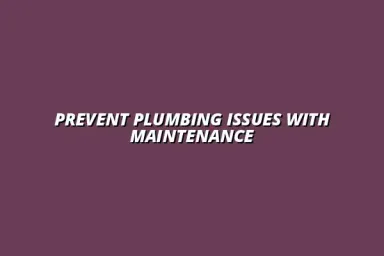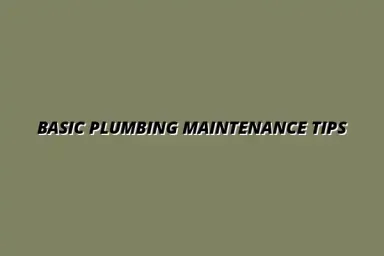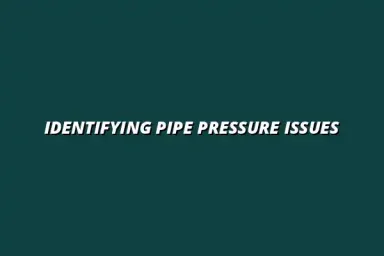Understanding the Risks of Frozen Pipes in Winter
Winter can bring beautiful snow but also serious plumbing issues. One of the biggest risks homeowners face is the possibility of frozen pipes. When the temperature drops, water inside pipes can freeze and expand, leading to potential bursts. This can cause extensive damage to your home and create costly repairs! Understanding the causes of bursting water pipes is crucial for prevention.
To avoid these issues, it's essential to understand how cold weather affects plumbing systems. Pipes that are exposed to cold air, such as those in unheated areas, are more likely to freeze. Moreover, factors like wind chill and sudden temperature drops can increase the risk. Being informed is the first step in prevention!
How Cold Weather Affects Plumbing Systems
Cold weather impacts plumbing systems by lowering the temperature of the water inside the pipes. When the temperature reaches 32°F (0°C), the water can start to freeze. This is particularly true for pipes located in exterior walls, attics, and basements where there is less heat.
- Pipes made of metal conduct heat away more quickly, increasing risk.
- Older homes may have less insulation, making them more vulnerable.
- Sudden temperature fluctuations can cause a rapid freeze, catching homeowners off guard.
Understanding these factors can help you take the right steps to protect your plumbing. For more tips on winter plumbing, check out these winter plumbing tips to prevent freezing. It's crucial to keep a close eye on temperatures and the condition of your home’s plumbing system during winter.
Signs that Your Pipes are at Risk of Freezing
Identifying the signs of potential frozen pipes early can save you from major headaches. If you notice any of the following, your pipes may be at risk:
- Unusual frost on exposed pipes.
- Water pressure drops suddenly.
- Strange noises in your plumbing system.
- Toilets not flushing properly or slow drainage.
Even if you don’t see any signs, it’s wise to be proactive. Pay attention to the temperature and the location of your pipes. Areas that stay cold are more prone to freezing! Regular plumbing maintenance, such as described in this guide to essential plumbing maintenance for homes, can help prevent many issues.
Effective Strategies to Prevent Frozen Pipes
Preventing frozen pipes involves a combination of insulation, heating solutions, and temperature maintenance. Let's explore some effective strategies to protect your plumbing during the chilly months.
Responding to Frozen Pipes: What to Do
Finding frozen pipes in your home can be alarming, especially during the harsh winter months. It's essential to act quickly to prevent further damage. Understanding how to identify and respond to frozen pipes can save you a lot of time, money, and stress!
To effectively respond, start by checking the areas where pipes are most vulnerable to freezing, such as basements, attics, and exterior walls. Knowing where to look makes it easier to address the issue. Here’s what you should do if you suspect you have frozen pipes:
Identifying Frozen Pipes in Your Home
Frozen pipes can be tricky to spot, but there are some telltale signs. One common indicator is a lack of water flow from your faucets. If you turn on the tap and only a trickle or no water at all comes out, this could mean you have a frozen pipe.
Additionally, you should also check for:
- Frost or condensation on the pipes
- Unusual sounds like banging or gurgling when turning on faucets
- Cracks or bulges in the pipes themselves
If you observe any of these signs, it’s crucial to take immediate action! Addressing issues like preventing bathroom sink pipe clogs can also help prevent bigger problems down the line.
Steps to Take if You Find a Frozen Pipe
Once you’ve confirmed that a pipe is frozen, follow these steps to address the issue safely:
- Turn off the water supply to prevent any potential overflow or leaks.
- Open the faucet connected to the frozen pipe. This allows water to flow once it starts melting.
- Apply gentle heat to the frozen section of the pipe using a hairdryer, heat lamp, or towels soaked in hot water. Avoid using open flames!
- Keep checking for water flow every few minutes until normal flow resumes.
Remember, patience is key! Take your time to safely thaw the pipe without causing damage. If you need emergency plumbing services, consider contacting a plumber in Billesley, Birmingham or a similar local service.
Frequently Asked Questions about Pipe Prevention
Understanding frozen pipes is essential, but many homeowners have common questions. Let’s dive into some of these frequently asked questions.
What Temperature Causes Pipes to Freeze?
Pipes can freeze when temperatures drop below 32°F (0°C). However, several factors can affect this, such as wind chill, insulation, and the type of pipe material. Generally, pipes in unheated areas are at greater risk.
Here are some critical factors to consider:
- Location: Pipes in exterior walls are more vulnerable.
- Insulation: Poorly insulated pipes are at higher risk.
- Flow: A lack of water movement in the pipes increases the chances of freezing.
How Can Homeowners Monitor Their Pipe Health?
Monitoring the health of your pipes is crucial, especially during winter. Regular checks can help you catch potential issues before they escalate. Consider these monitoring tips:
- Check for signs of leaks regularly.
- Inspect insulation around pipes to ensure it remains intact.
- Keep an eye on water pressure; significant drops may indicate a problem.
Staying proactive can help you avoid the headache of dealing with frozen pipes! Don't forget the importance of winter bathroom plumbing leak prevention.
Long-Term Solutions for Winter Pipe Protection
Thinking ahead can significantly reduce the risks of frozen pipes in the future. Implementing long-term solutions is a smart way to protect your home.
Investing in Plumbing Upgrades for Cold Climate
In areas prone to freezing temperatures, investing in upgraded plumbing can make a huge difference. Consider options such as:
- Installing insulated pipes
- Using heat-resistant materials
- Upgrading to modern, more resilient plumbing systems
These upgrades can offer enhanced protection during the winter months and contribute to the overall health of your plumbing system. Regular maintenance of your water heater, as suggested in our guide to annual water heater inspection tips, is also critical.
Creating a Year-Round Maintenance Plan
Developing a maintenance plan is a great way to keep your plumbing in good shape. Here are some steps to consider:
- Schedule regular inspections of your plumbing system.
- Clean gutters and downspouts to prevent ice dams.
- Ensure indoor temperatures remain consistent, especially in utility areas.
By taking these steps throughout the year, you can help prevent frozen pipes and keep your home safe!
Final Thoughts and Actionable Steps
When it comes to preventing frozen pipes, knowledge is power! By understanding the risks and implementing effective strategies, you can protect your home.
Summarizing Key Prevention Methods
Remember to insulate your pipes, maintain a steady indoor temperature, and take precautions outdoors. These simple steps can significantly reduce your risk of encountering frozen pipes this winter!
Encouraging Proactive Maintenance Before Winter
As winter approaches, it’s crucial to be proactive. Check your plumbing systems, insulate where needed, and stay informed about the conditions in your area. Taking these actions will ensure a warmer and safer home during the cold months!

 Kiran Almasi
Kiran Almasi

